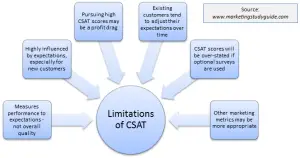What are the Limitations of CSat? (Customer Satisfaction)
As we know, there are many benefits of customer satisfaction and many firms strive to maximize their CSat scores. In service firms in particulars, customer satisfaction is often their key marketing goal (and most significant marketing metric) that is regularly tracked and assessed.
However, there are a number of limitations of customer satisfaction in terms of relying too heavily on this marketing metric. It is, therefore, important to understand the various limitations in order to utilize the results of CSat research/scores appropriately.

(Click to enlarge)
Main limitations of customer satisfaction (CSAT)
- Expected versus delivered value is being measured – CSAT is NOT necessarily a measure of overall value or quality of the firm and its offerings
- High CSAT scores may be simply a reflection of low expectations of the firm
- High CSAT scores may not deliver increased profitability (and may even have a negative financial impact – primarily due to the firm over-delivering increased customer value)
- Existing customers will adjust their expectations to the value regularly being delivered, resulting in most customers being “just satisfied” (reflected in average, not high, CSAT scores). This means that it is difficult (high effort and cost) to maintain very high satisfaction scores over a long period of time
- More engaged and involved customers are more likely to participate in optional market research surveys, such as online surveys, potentially leading to an overestimation of CSAT levels
- There are better measures available – for the aggregate of factors that customer satisfaction is suggested to address (which include of loyalty, customer profitability, likeability of the firm, word-of-mouth potential, and so on).
ALSO SEE
The article that discusses each of these factors in more detail.
